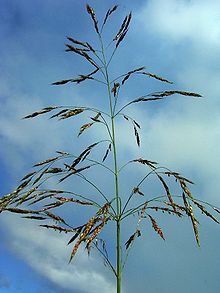|

Johnson Grass, Johnsongrass and Sorghum halepense L. Pers.
Sorghum halepense, commonly called Johnsongrass, is a plant in the grass family, Poaceae, native to the Mediterranean region, but growing throughout Europe and the Middle East. The plant has been introduced to all continents except Antarctica, and most larger islands and archipelagos. It reproduces by rhizomes and seeds.
Johnsongrass has been used for forage and to stop erosion, but it is often considered a weed for the following reasons:
- Foliage that becomes wilted from frost or hot dry weather can contain sufficient amounts of hydrogen cyanide to kill cattle and horses if it is eaten in quantity.
- The foliage can cause 'bloat' in such herbivores from the accumulation of excessive nitrates; otherwise, it is edible.
- It grows and spreads so quickly that it can 'choke out' other cash crops that have been planted by farmers.
This species occurs in crop fields, pastures, abandoned fields, rights-of-way, forest edges, and along streambanks. It thrives in open, disturbed, rich, bottom ground, particularly in cultivated fields. Johnsongrass resistant to the popular herbicide glyphosate has been found in Argentina and the United States. It is considered to be one of the ten worst weeds in the world.
It is named after an Alabama plantation owner, Colonel William Johnson, who sowed its seeds on river-bottom farm circa 1840. The plant was already established in several US states a decade earlier, having been introduced as a prospective forage or accidentally as a seedlot contaminant.
For More Information:
Johnsongrass 
Johnsongrass Control (An excellent, comprehensive article) 
Weed of the Month: Johnsongrass 
|